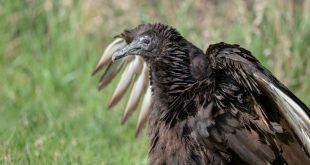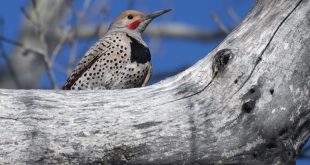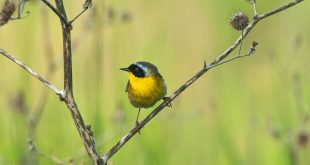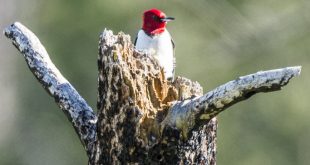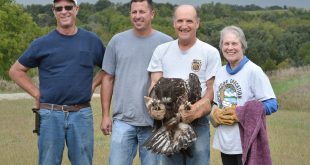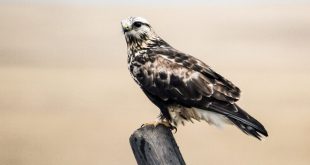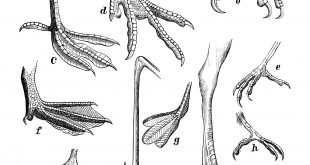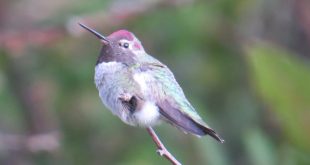By Joel Jorgensen Spring is a period when many birds are on the move. This means it is a great time of year for birders to be on the lookout for rarities or vagrants. A rarity is a bird that usually appears somewhere outside of its normal range. Finding a rarity sometimes requires special effort, but other times, it’s just luck. On April 26, birder and photographer Steve Kruse discovered a vulture on the ground at Merganser Recreation Area in …
Read More »Common Woodpeckers of Nebraska
By Amber Schiltz Woodpeckers are special birds known for exactly what their name describes — “pecking” at wood. Using their strong beaks to drill into living or dead trees helps them look for tasty bugs, build cozy nests for their young, and even allows them to talk to one another by the the sound of their drilling. Woodpeckers have incredible adaptations, or tricks, to help them drill. This includes a stiff tail that keeps them from falling as they drill …
Read More »WMA Habitat Fuels Songbird Migration
By Stephen Brenner and Joel Jorgensen, Nongame Bird Program managers Migration is a critically important event in the lives of many avian species. This period accounts for over a quarter of the annual cycle for some birds and is extremely risky as individual birds travel long distances through unfamiliar areas. Consequently, many species experience higher rates of mortality compared to the breeding or wintering periods. Some of the smallest migratory species in North America also can travel the longest distances, …
Read More »Barn Owl Rescue
An Act of Devotion Nebraska Game and Parks district offices get many calls about wildlife. The call I received about stranded baby barn owls was no exception. A rural family was getting ready to tear down a dilapidated barn on their property when they noticed a baby owl peering over a ledge near the rafters. True stewards of wildlife, they called their local Nebraska Game and Parks office to find out what they could do. Typically, this type of information …
Read More »Those Fiery Redheads
Beauty or beast, this woodpecker has an eye-catching appearance Aerial proficiency to swoop and snatch prey from the sky. Symmetrically arranged talons for clinging to vertical surfaces and a chiseled beak that hammers hardwood surfaces at 1,000 times the force of gravity. A long barbed tongue, three times as long as that self-sharpening dagger-like bill, for retrieving victims from deep within a crevice. All that, and a fiery red head. If readers were to consider that description alone, they might …
Read More »Just an Eagle
Last spring, I received a call from conservation officer Matt Seitz who asked me to pick up an eagle that had fallen from a nest near Barneston. Although I was on vacation at the time, I couldn’t pass up the opportunity to hold a baby eagle. I said I would get it and went out to meet the farmer who knew where the bird was located. Gary Remmers was working in his field on April 27 when he noticed something …
Read More »Ol’ Rough-legs
The rough-legged hawk may not stand out among raptors in looks, but it lives an interesting life. Perhaps you have seen this species along the road lately, but given its somewhat unassuming appearance, have not given it much thought. The rough-legged hawk, with its mottled brown plumage, blends in well with our landscape during the winter months. The rough-legged hawk is one of those species that logs many miles a couple of times annually. Those fence posts and utility poles …
Read More »Walk This Way
Just like the shape of its bill, a bird’s feet can tell us a lot about its ecology and the habitat in which it lives. Birds do a lot with their feet – they can perch, walk, preen, feed, carry/hold objects and even swim. These animals are considered digitigrade, meaning they generally walk on their toes, not their entire foot like people do. Most birds have four toes, or digits, while some species only have three. These digits are arranged …
Read More »The Red Crossbill
A distinctive finch with an unusual beak The red crossbill is a distinctive finch whose crooked beak usually catches one’s attention. Rather than being a deformity, the odd beak is an adaptation that the bird uses to extract its preferred food source – seeds from the cones of conifers such as pines, spruces and firs. Although its specialized beak may give the red crossbill an advantage in foraging on its preferred cone type, its relationship with conifer cone seeds is …
Read More »The end of the Nongame Bird Blog
Individuals that have visited this blog over the past six years to read one or more of the 300+ posts will have noticed that the frequency and quality of the blog posts has ebbed over the last year. The principal reason this occurred is because I have focused much of my extracurricular time and energy on the Birds of Nebraska – Online. I have a recent post on this blog describing what that project is all about. Because work on the …
Read More » Nebraskaland Magazine
Nebraskaland Magazine
